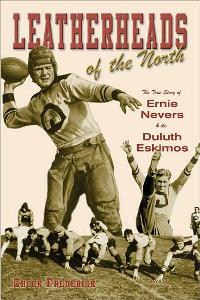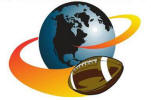|
| |
Back
to Articles Menu
Book Report: Leatherheads of the North
by
Randy Snow
Originally
posted on AmericanChronicle.com, Thursday, August 7, 2008
In the new book.
Leatherheads of the North, author Chuck Frederick tells
the story of one of the early teams in the National Football
League, the 1926-27 Duluth Eskimos. The Eskimos and their
star player, Ernie Nevers, barnstormed their way across the
country, playing 29 games during the 1926 season, with 28 of
those games being played on the road.
The NFL was a fairly new league at the time. It was born in
1920 and was originally known as the American Professional
Football League. Football great Jim Thorpe was its first
president. The name was changed to the National Football
League in 1922.
 From
1923-1925, the NFL team in Duluth, Minnesota was simply
known as Kelley-Duluth because it was owned, in part, by
Michael Hugh Kelley, the owner of the local Kelley Hardware
store. From
1923-1925, the NFL team in Duluth, Minnesota was simply
known as Kelley-Duluth because it was owned, in part, by
Michael Hugh Kelley, the owner of the local Kelley Hardware
store.
When the Kelley-Duluth team was putting together its first
roster in 1923, many players came from a semi-pro league
organized by the local shipyard workers. One of those
shipyard workers was Harry Grant, whose son, Bud Grant,
would one day become the head coach of another NFL team, the
Minnesota Vikings.
The Kelley-Duluth team posted a 4-3 record in 1923 and was
5-1 in 1924. However, in 1925, the team had a hard time
finding opponents to fill out its schedule and only played
three games. (In those days, it was up to the individual
teams to schedule their own opponents.) They lost all three
of their games in 1925.
Late in the 1925 NFL season, George Halas signed college
football superstar Red Grange from the University of
Illinois to play for his Chicago Bears. The signing produced
sellout crowds wherever the Bears played and brought the NFL
from sports obscurity to national attention. Until Grange
signed on with the Bears, pro football was seen as a fad and
very much inferior to the more highly popular college game.
Legendary University of Chicago football coach Amos Alonzo
Stagg even declared once that if any of his former college
players went on to play professional football, he would
revoke their varsity letters!
Grange was the highest paid player in the league at the
time. But after the 1925 season was over, Grange wanted even
more money to return to the Bears in 1926. He and his agent,
C.C. Pyle, were looking for a five-figure salary and a
one-third ownership in the team. Halas refused.
Grange and Pyle then went out and secured a lease to play in
New York´s Yankee Stadium and asked the NFL to grant them an
expansion team. The league already had a team in town, the
New York Giants, so his request was denied.
Since they already had a lease, Grange and Pyle decided to
form a rival league to the NFL. They called it the American
Football League. Grange would play for his own team, the New
York Yankees.
Losing their most marketable star and now having a rival
league to deal with, the NFL needed to do something that
would keep fans interested in the league.
In 1926, Ole Haugsrud assumed co-ownership of the
Kelley-Duluth team. Haugsrud saw what signing a player like
Red Grange could do to bring fans out to the games, so one
of the first things he did as the new owner was to sign
Ernie Nevers to a contract. Haugsrud and Nevers had been
friends ever since they attended high school together in
Superior, Wisconsin, just south of Duluth.
Nevers was a college football All-American out of Stanford
who also appeared in Hollywood movies, mostly westerns. He
played linebacker and running back and was also a kicker and
punter. His coach at Stanford was Pop Warner, who had also
coached Jim Thorpe at the Carlisle Indian School in
Pennsylvania years earlier. Warner considered Nevers to be
an even better football player that Thorpe.
After announcing at the NFL owners meeting in Chicago in
August of 1926 that he had signed Nevers to his team,
Haugsrud had no trouble finding teams to fill out his 1926
schedule. He also changed the name of the team to the Ernie
Nevers´ Eskimos. He left the meeting with a schedule that
consisted of 14 league games. He also scheduled another 15
exhibition games against teams that were not members on the
NFL at the time. (The NFL referred to the team as the Duluth
Eskimos, but the team´s equipment cases and their sideline
coats proudly featured the words, "Ernie Nevers´ Eskimos,
Duluth.") The addition of a college superstar like Nevers
was considered by many as a move that single-handedly saved
the NFL.
Because of the bad reputation that pro football had in the
1920´s, many players used assumed names to play pro
football. Some even played for their college team on
Saturdays and then suited up for a pro team in another city
on Sunday using their fictitious names. In fact, in one
game, the University of Michigan team donned the uniforms of
the NFL Detroit Heralds and took on the Toledo Mudhens,
which was made up of players from Ohio State University.
The Eskimos had one such player on their team as well, John
Victor McNally. He played under the name Johnny Blood so he
wouldn´t lose the one year of college eligibility that he
still had. McNally came up with the name after driving past
a movie theater one day that was showing a new Rudolph
Valentino movie titled, "Blood and Sand."
After playing their opening game in Duluth on
September 19, 1926 against the NFL Kansas City Cowboys, the Eskimos hit the
road. They played a total of 29 games over the course of 117 days and did not
return home to Duluth until February 5, 1927. They traveled the country from
Portland, Maine to San Francisco and sometimes played games just a few days
apart.
Many times during the grueling season, the Eskimos were forced to play with only
13 active players on their roster because of injuries. They had started out the
season with 18 players and the league limit at the time was 22. Team owner
Haugsrud and head coach Dewey Scanlon would often don uniforms and participate
in pre-game warm ups just to make it look like they had more players on the
team.
In the 14 NFL games they played that season, the Eskimos posted a 6-5-3 record.
Despite their NFL record, Chicago Bears owner and head coach George Halas
declared that the 1926 Eskimos were "the greatest team ever put together."
Red Grange´s American Football League folded after just one season, but his New
York Yankees team survived and was allowed to join the NFL in 1927.
The Eskimos played only nine NFL games and a handful of exhibition games in 1927
and finished with a disappointing 1-8 record. Again, all their games were played
on the road. Nevers was also the head coach of the team in 1927.
The Eskimos ceased operation following the 1927 season due to financial
problems, but Haugsrud maintained ownership of the team. In 1929, he reluctantly
sold the franchise to a group from New Jersey who resurrected the team as the
Orange Tornados. That was the same year as the stock market crash, which led to
the Great Depression.
Because he sold the team for less than he was asking for, Haugsrud included a
stipulation with the sale. It stated that if the NFL ever brought a team back to
Minnesota, he would have a chance to, once again, be the team owner. The NFL
agreed.
Then, in 1960, the NFL approved an expansion team in Minneapolis, the Minnesota
Vikings. Thirty-two years after the Eskimos played their last game, Haugsrud
paid $60,000 and received 10% ownership in the Vikings.
In 1967, Haugsrud traveled to Canada to visit an old friend, Bud Grant, who was
the head coach of the Winnipeg Blue Bombers of the Canadian Football League at
the time. That meeting led to Grant being hired as the head coach of the Vikings
later that year. Grant led the team to many division titles and four Super Bowl
appearances before he retired in 1985.
Some people even believe that the original Eskimos team lives on today as the
Washington Redskins. However, record keeping was not as accurate in the early
days of the NFL as it is today, so we may never know for sure.
Ernie Nevers did not play in 1928 because of injuries. Instead, he became an
assistant coach at his college alma mata, Stanford. But in 1929, he joined the
Chicago Cardinals and played for the team until 1931. Nevers was also a major
league pitcher for the St. Louis Browns from 1926-1928. He gave up two home runs
to Babe Ruth during that time.
Johnny "Blood" McNally played for the Pottsville Maroons in 1928 and also went
on to play for the Green Bay Packers and the Pittsburgh Pirates.
Nevers and McNally were among the 17 original members enshrined in the Pro
Football Hall of Fame in Canton, Ohio in 1963. Other members of the Class of
1963 included Jim Thorpe, George Halas, Red Grange, Don Hutson, Curley Lambeau,
Sammy Baugh and Bronko Nagurski. Another former Eskimo player, guard Walter
Kiesling, was enshrined in the Hall of Fame in 1966. Nevers was also inducted
into the College Football Hall of Fame in 1951.
The story of the Duluth Eskimos was the inspiration for the 2007 film
Leatherheads starring George Clooney and Renee Zellweger. In the movie,
however, the team was called the Duluth Bulldogs.
In 2003, Ernie Nevers was one of four NFL players featured on U.S. Postage
Stamps honoring Early Football Heroes. The others were Red Grange, Walter Camp
and Bronko Nagurski.
The Duluth Eskimos just might be the greatest NFL team that you have never heard
of. The team produced three Hall of Famers during their two years in the
fledgling NFL and brought the league to new fans all over the country. Today,
the team has its own display at the Hall of Fame in Canton.
The book´s author, Chuck Frederick, is the Deputy Editorial Page Editor and a
columnist for the Duluth News Tribune newspaper.
LINKS
Pro Football Hall of
Fame Official Web site
Leatherheads Movie
Official Web Site
Back
to Articles Menu
|
 From
1923-1925, the NFL team in Duluth, Minnesota was simply
known as Kelley-Duluth because it was owned, in part, by
Michael Hugh Kelley, the owner of the local Kelley Hardware
store.
From
1923-1925, the NFL team in Duluth, Minnesota was simply
known as Kelley-Duluth because it was owned, in part, by
Michael Hugh Kelley, the owner of the local Kelley Hardware
store.
